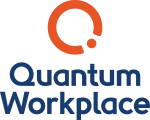Employee Recognition: What It Is, Why It Matters, and How to Use it Effectively
This article discusses employee recognition, why it’s important, and best practices to boost employee recognition in the workplace.
CONTENTS
- Intro
Back to top
Intro
Think about the last time you put your heart and soul into a project or presentation, molded it into something you were proud of, and absolutely nailed the execution. That feeling of accomplishment is uplifting, but it’s multiplied exponentially when others take notice. The simple act of acknowledging achievement is a major boost for employee morale and performance.
And that’s why employee recognition is so critical. When employees are rewarded for their contributions, they feel ownership and pride and are willing to work just as hard on their next project. Recognition connects them to the organization, elevates performance, and increases the likelihood they’ll stay. This article lays out how to give the kind of recognition that will truly make a difference in employee engagement, performance, and retention.
SHORT ON TIME?
Read this later! Email a PDF version to yourself now.
1
What is Employee Recognition?
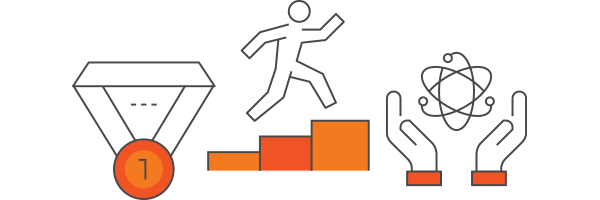
Employee recognition is the open
A detailed research study by Quantum Workplace identified employee recognition as a
If you regularly give out authentic, deserved recognition to employees, you’ll be that much
1. Showcase Goal Achievement
Why does it feel so good to get a simple “thank you” from someone? All humans feel the need to be praised at some level. They want to know that their hard work and achievements aren't going unnoticed. When a person achieves a goal, personal or work-related, they feel a rush of achievement, and that good feeling is only amplified when others recognize and acknowledge the achievement as well.
2. Motivate Effort
Recognition can be tied to more than just performance. Celebrate strong effort when employees go above and beyond. This helps them develop emotional connections to the workplace that fuel future performance.
3. Reinforce Values
Achievements and actions that are recognized more frequently show employees what is valued by managers, leaders, and the organization as a whole. When we receive positive recognition for an action, we tend to associate that action with a reward and try to achieve that feeling again in future actions. So recognizing certain actions can reinforce the values an organization wants in its culture.
2
Types of Employee Recognition
The “how” of recognition is very important. Every employee embraces recognition differently. Some get a boost from public praise, while introverted workers prefer a subtle or private gesture. After identifying the employee’s personality type, openly encourage them through the types of recognition and appreciation that mean the most to them.
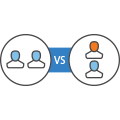
Peer vs. Superior
Receiving positive feedback from a manager or higher up is a validation of good work. Impressing a superior increases job security and the likelihood of a promotion or pay bump. But sometimes it feels just as good to be recognized by a coworker, even from someone lower on the org chart. Regardless of where it comes from, recognition feels good.

Attributed vs. Anonymous
Most recognition is given by a known party. There’s typically no reason to separate recognition from the giver. But sometimes an anonymous shout-out or thank you card on an employee’s desk can have just as much power. It removes the thought that the giver is doling out recognition to seem like a team player rather than authentically expressing appreciation.
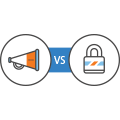
Social vs. Private
As mentioned above, no two employees prefer recognition the same way. Some crave the spotlight; others avoid it like the plague and would prefer subtle praise. Recognition should be tailored to the preferences of each individual’s personality.

Behavior vs. Achievement
Recognition is often linked to metrics, such as hitting a sales goal or staying with an organization for 20 years. But praise can also be lauded for working extra hours, going above and beyond to aid a coworker, or for successfully organizing an awesome company party.
3
Why Does Recognition Matter?
The old-school line of thinking says that employees shouldn’t need recognition to succeed. They should be motivated to keep their job and increase their salary. There’s some truth to that – employees should take pride in their work and be motivated for reasons other than praise. But spotlighting strong performance is the frosting on the cake. It transforms a satisfied employee into one who actively pushes for greater things.
Don’t believe us? Here are some stats to prove the importance of employee recognition.
Here are just a few benefits of employee recognition:
It stabilizes the workplace.
Many people leave their jobs due to lack of recognition, while recognition is one of the top drivers for attracting candidates. Recognition not only reduces turnover, but it brings the top talent into your organization.
It increases productivity.
Employees work harder and more efficiently when they’re routinely recognized for strong work. Celebrating good work encourages employees to continually chase that praise.
It improves team culture.
Employee recognition encourages staff members to see positive attributes in one another. Allowing coworkers to nominate one another is extremely valuable, as it demonstrates they value each other’s contributions to the team. Research shows that 86 percent of employees say recognition makes them feel happier at work.
It engenders trust between managers and employees.
Receiving positive feedback strengthens the relationship between bosses and their direct reports. According to a 2017 study, nearly 90 percent of employees who received recognition from their boss indicated high levels of trust in that relationship, versus just 48 percent for those who received no recognition.
It lowers employee stress and absenteeism.
When employees are recognized for a job well done, they don’t have to worry about whether they’re putting in good work. Recognition reaffirms that their efforts are helping the organization, which can increase engagement and possibly lead to fewer sick days and tardiness.
It improves the customer experience.
An engaged employee leads to a satisfied customer. Research by Quantum Workplace found that leading customer service organizations report 60 percent more engaged employees.
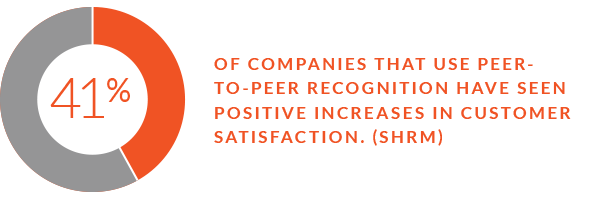
4
What Does Recognition Look Like?
You now understand the why behind employee recognition, but how do you put it into practice?
There’s no set-in-stone answer – it can look different in every workplace, depending on the personalities of the employees and the culture of the organization. Here are some really cool employee appreciation ideas we’ve seen:

SNACKNATION - "CRUSH IT" MEETINGS
The entire team from this healthy snack delivery company gathers each Friday afternoon to recognize one another. The staff goes around the room nominating other team members who “crushed it” over the past week. It’s helped the company maintain its connected culture even as it’s expanded from 30 to more than 100 employees.

CLOUD 9 LIVING - 'G' BOOK
Employees are encouraged to recognize each other by writing complimentary notes in the company’s book of “good stuff.” Submissions, both personal and work-related, are read aloud weekly at a company meeting. Employee recognition ideas like this have helped the company be featured on Today, The Talk, and The Ellen Degeneres Show.

GROUND FLOOR MEDIA - WEBSITE CALL-OUT
This Denver-based communications firm has a section of their website dedicated to a featured team member who’s performed well recently. These posts recognize employees for their lives and passions outside of work in addition to their contributions to the company.
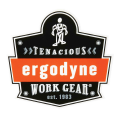
ERGODYNE - WELLNESS GOALS
Recognition doesn’t have to be all about work. Ergodyne, a protective workwear manufacturer, highly encourages its employees to stay healthy, recognizing and incentivizing them for hitting personal fitness or nutrition goals.

BEST WESTERN - SOCIAL SHOUT-OUT
Extend recognition beyond your organization’s population. A Chicago location of the hotel chain created a Facebook page for employee Wallace Pope, calling him a “Star of the Industry.” Twitter, Facebook, and LinkedIn are all easy ways to share standout employees with a greater audience.
It’s important to note that not all employee recognition programs are created equal. When recognition is private, it can come across as stale and inauthentic. The best recognition programs publicly highlight successes (including ones that aren’t work-related), allow peers to celebrate one another, and are tied to individual, team, or organization goals. And above all, your recognition program should reflect your organization’s culture. Recognition should align with your core values and cement their importance.
There are hundreds of ways to recognize employees, and plenty of organizations have developed personalized programs to build up employees. Any company can benefit from adding employee recognition software that allows coworkers to encourage and celebrate each other without added strain on HR.
5
Wrapping Up
Employee recognition is a pillar of employee engagement, and utilizing it maximizes your teams’ and organization’s potential. Appreciated employees are more likely to work hard and less likely to leave, and they come together to create a strong culture that builds revenue and creates a strong customer experience.
"I consider my ability to arouse enthusiasm among my people the greatest asset I possess... If I like anything, I am hearty in my appreciation and lavish in my praise."
- Sam Walton, founder of Walmart


